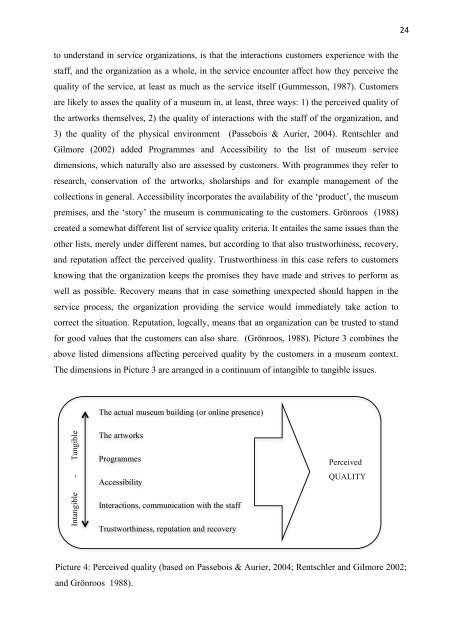Is there more to it than posting a status update?
Is there more to it than posting a status update?
Is there more to it than posting a status update?
You also want an ePaper? Increase the reach of your titles
YUMPU automatically turns print PDFs into web optimized ePapers that Google loves.
<strong>to</strong> understand in service organizations, is that the interactions cus<strong>to</strong>mers experience w<strong>it</strong>h the<br />
staff, and the organization as a whole, in the service encounter affect how they perceive the<br />
qual<strong>it</strong>y of the service, at least as much as the service <strong>it</strong>self (Gummesson, 1987). Cus<strong>to</strong>mers<br />
are likely <strong>to</strong> asses the qual<strong>it</strong>y of a museum in, at least, three ways: 1) the perceived qual<strong>it</strong>y of<br />
the artworks themselves, 2) the qual<strong>it</strong>y of interactions w<strong>it</strong>h the staff of the organization, and<br />
3) the qual<strong>it</strong>y of the physical environment (Passebois & Aurier, 2004). Rentschler and<br />
Gil<strong>more</strong> (2002) added Programmes and Accessibil<strong>it</strong>y <strong>to</strong> the list of museum service<br />
dimensions, which naturally also are assessed by cus<strong>to</strong>mers. W<strong>it</strong>h programmes they refer <strong>to</strong><br />
research, conservation of the artworks, sholarships and for example management of the<br />
collections in general. Accessibil<strong>it</strong>y incorporates the availabil<strong>it</strong>y of the ‘product’, the museum<br />
premises, and the ‘s<strong>to</strong>ry’ the museum is communicating <strong>to</strong> the cus<strong>to</strong>mers. Grönroos (1988)<br />
created a somewhat different list of service qual<strong>it</strong>y cr<strong>it</strong>eria. It entailes the same issues <strong>than</strong> the<br />
other lists, merely under different names, but according <strong>to</strong> that also trustworhiness, recovery,<br />
and reputation affect the perceived qual<strong>it</strong>y. Trustworthiness in this case refers <strong>to</strong> cus<strong>to</strong>mers<br />
knowing that the organization keeps the promises they have made and strives <strong>to</strong> perform as<br />
well as possible. Recovery means that in case something unexpected should happen in the<br />
service process, the organization providing the service would immediately take action <strong>to</strong><br />
correct the s<strong>it</strong>uation. Reputation, logcally, means that an organization can be trusted <strong>to</strong> stand<br />
for good values that the cus<strong>to</strong>mers can also share. (Grönroos, 1988). Picture 3 combines the<br />
above listed dimensions affecting perceived qual<strong>it</strong>y by the cus<strong>to</strong>mers in a museum context.<br />
The dimensions in Picture 3 are arranged in a continuum of intangible <strong>to</strong> tangible issues.<br />
Intangible - Tangible<br />
The actual museum building (or online presence)<br />
The artworks<br />
Programmes<br />
Accessibil<strong>it</strong>y<br />
Interactions, communication w<strong>it</strong>h the staff<br />
Trustworthiness, reputation and recovery<br />
Perceived<br />
QUALITY<br />
Picture 4: Perceived qual<strong>it</strong>y (based on Passebois & Aurier, 2004; Rentschler and Gil<strong>more</strong> 2002;<br />
and Grönroos 1988).<br />
24















